Balance in anti-inflammatory herbal tea blends is key. It guarantees that the flavors and health benefits complement each other without one overpowering the others. When you start with a base herb like turmeric or ginger, adding complementary ingredients maximizes potency and taste. Too much of one herb can dominate, reducing overall effectiveness. By using ratios—50% base herbs, 30% complementary, and 15% flavoring—you create a blend that's enjoyable and powerful against inflammation. Understanding how these herbs work together is essential for crafting your perfect cup. Keep exploring to refine your blend and enhance both flavor and health benefits.
Importance of Herbal Balance

Herbal balance is essential when crafting effective anti-inflammatory tea blends. You'll want to ascertain that the flavors and properties of each herb complement one another, creating a harmonious blend that maximizes benefits. When you achieve balance, you can enhance the overall effectiveness of your tea, allowing you to tackle inflammation more efficiently.
Using a variety of herbs can help you target different aspects of inflammation. However, if you overload on one type, it may dominate the flavor or effects. So, take the time to contemplate the ratios of each herb. You might start with a base herb known for its anti-inflammatory properties and then add supporting herbs that can provide additional benefits, like soothing digestion or enhancing flavor.
Don't forget about the importance of aroma and taste. A well-balanced blend shouldn't only work wonders in your body but also be enjoyable to drink.
Key Ingredients for Anti-Inflammation
When creating an anti-inflammatory tea blend, selecting the right ingredients is essential for achieving ideal results. Start with turmeric, known for its active compound curcumin, which effectively reduces inflammation.
Ginger is another powerhouse, offering both flavor and anti-inflammatory properties that can soothe discomfort.
Next, consider adding green tea. Rich in antioxidants, it helps combat oxidative stress and inflammation.
You might also want to include cinnamon, which not only enhances taste but can also lower inflammatory markers in the body.
Don't forget about chamomile, famous for its calming effects. It can help reduce inflammation and promote relaxation, making it a perfect addition for your evening blend.
You could also try incorporating rosemary. This herb has rosmarinic acid that may help inhibit inflammatory processes.
Understanding Herbal Potency
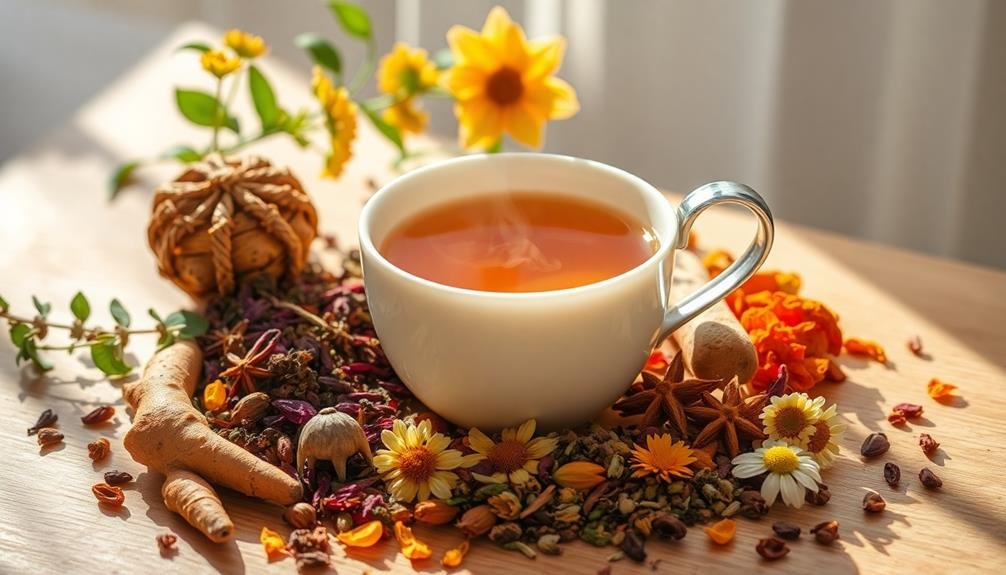
When it comes to herbal tea blends, understanding the potency of the active compounds is essential for their effectiveness.
You'll want to contemplate the right dosage to maximize benefits and how different herbs can work together in synergy.
This knowledge will help you create the most beneficial anti-inflammatory tea blends for your needs.
Active Compounds Overview
Understanding the active compounds in herbal tea blends reveals the potency of these natural remedies. Each herb contains unique bioactive compounds that contribute to their anti-inflammatory properties. For instance, curcumin in turmeric is well-known for its ability to modulate inflammatory responses, while gingerol in ginger offers similar benefits. Both compounds work synergistically in blends to enhance overall effectiveness.
Flavonoids found in herbs like chamomile and mint also play a significant role. They possess antioxidant properties that combat oxidative stress, a key player in inflammation. Additionally, polyphenols from ingredients like green tea support your immune system and reduce inflammation at a cellular level.
When you choose a tea blend, it's vital to reflect on how these active compounds interact. The balance of herbs can amplify their effects, making the blend more potent. For example, combining echinacea with elderberry may enhance the immune-boosting capabilities, while adding lemon balm can provide calming effects alongside anti-inflammatory benefits.
Recognizing the active compounds in your herbal tea not only enhances your understanding but also empowers you to select blends that best suit your health needs.
Dosage and Effectiveness
Determining the right dosage of herbal tea blends is vital for maximizing their anti-inflammatory effects. You want to guarantee that you're getting the most benefit from the herbs you're using. Too little may not provide the desired relief, while too much could lead to unwanted side effects.
Here are some key points to take into account when it comes to dosage and effectiveness:
- Start Small: Begin with a lower dosage to gauge your body's response.
- Follow Recommendations: Always check packaging or consult with a herbalist for specific guidance.
- Monitor Effects: Pay attention to how your body reacts after consumption.
- Adjust as Needed: If you feel comfortable, gradually increase the dosage.
- Stay Consistent: Regular intake can enhance the overall benefits of your herbal tea blend.
Understanding herbal potency is essential. Each herb has its own unique properties, and the right balance can amplify their effectiveness.
Synergy in Blends
In herbal tea blends, synergy plays a crucial role in enhancing the potency of individual ingredients. When you combine different herbs, their unique properties interact, creating a more significant effect than any single herb alone.
For instance, pairing turmeric with ginger can amplify their anti-inflammatory benefits, making your tea blend more effective in combating inflammation.
You might wonder how this works. Each herb contains various compounds that target different aspects of inflammation. By combining them, you're not just addressing one symptom but attacking the root cause from multiple angles. This synergistic approach can lead to improved overall health outcomes.
It's essential to reflect on the ratios and types of herbs you use. Some herbs can overshadow others if they're too dominant, which could diminish the blend's overall effectiveness.
For example, while peppermint adds a revitalizing flavor, it shouldn't overpower the more subtle notes of chamomile or hawthorn.
Ideal Blending Ratios
Creating a balanced herbal tea blend is essential for maximizing its anti-inflammatory benefits. The right blending ratios can enhance the effectiveness of each ingredient, making your tea a powerhouse of wellness.
To achieve this balance, consider the following ideal ratios:
- Base Herbs (50%): Choose strong anti-inflammatory herbs like turmeric or ginger as your foundation.
- Complementary Herbs (30%): Add herbs like chamomile or peppermint that support digestion and relaxation.
- Flavoring Agents (15%): Incorporate a touch of citrus zest or cinnamon for a pleasant flavor without overpowering the blend.
- Supporting Botanicals (5%): Include a few adaptogens or superfoods, such as ashwagandha or spirulina, to elevate the blend's health benefits.
- Personal Touch: Don't forget to add a pinch of your favorite herb to make the blend uniquely yours!
Experimenting with these ratios allows you to tailor your herbal tea to your taste preferences while maintaining its anti-inflammatory properties.
Remember, the key is to strike a harmonious balance that not only tastes good but also provides the health benefits you're looking for.
Techniques for Effective Blending
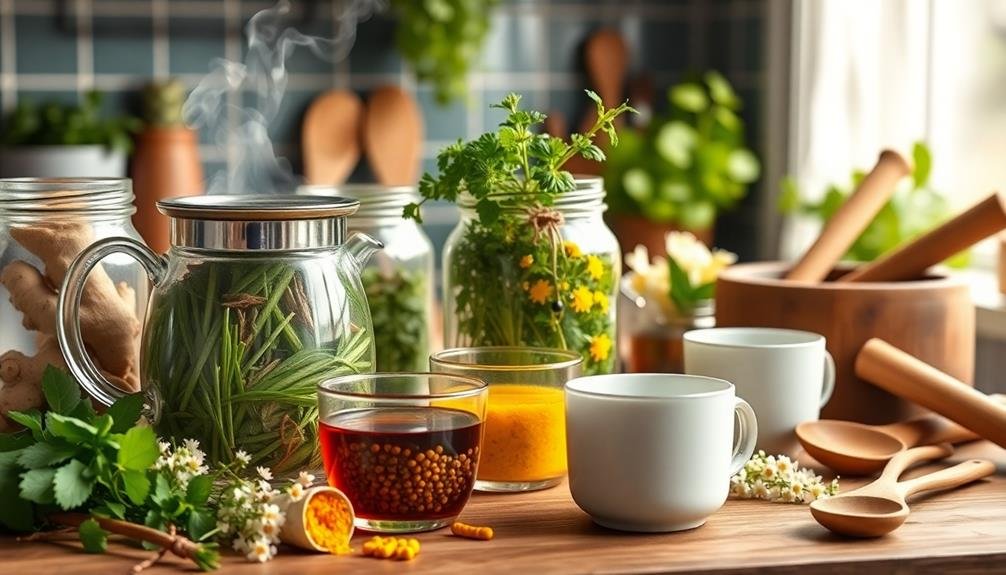
Mastering effective blending techniques is essential for crafting a harmonious herbal tea. To start, make certain you measure your ingredients accurately. Using a scale can help you achieve consistent ratios every time. Next, consider the texture of your herbs. Coarse herbs tend to require longer steeping times, while finer herbs may release their flavors quickly.
Experimenting with different blending methods can also enhance your tea. Try layering your herbs in a jar, allowing the scents to mingle before you brew. Here's a quick reference table to guide your blending process:
| Technique | Description | Tips |
|---|---|---|
| Measuring | Use a scale for accurate ratios | Weigh dry ingredients separately |
| Layering | Combine herbs in a jar | Let scents mingle for a day |
| Grinding | Crush herbs for better infusion | Use a mortar and pestle |
| Steeping | Adjust time based on herb texture | Monitor closely for best flavor |
| Tasting | Sample your blend before finalizing | Adjust ratios to preference |
Flavor Profiles and Health Benefits
Understanding the flavor profiles and health benefits of your herbal tea blends can elevate your brewing experience. By selecting ingredients that not only taste great but also offer health advantages, you can create a delightful and beneficial cup.
Here are some key flavors and their corresponding benefits to take into account:
- Ginger: A warming spice that aids digestion and reduces inflammation.
- Turmeric: Known for its earthy flavor, it has strong anti-inflammatory properties thanks to curcumin.
- Peppermint: This invigorating herb can soothe headaches and improve digestion while adding a cool taste.
- Chamomile: With its mild, floral notes, chamomile is excellent for relaxation and can help with sleep.
- Lemon Balm: Offering a lemony flavor, it's known to reduce stress and improve mood.
When you blend these flavors, you're not just crafting a beverage; you're creating a holistic experience.
By understanding how each ingredient contributes to both taste and wellness, you can enhance your daily routine and promote overall health.
Customizing Your Tea Blend

When customizing your tea blend, think about selecting complementary ingredients that enhance both flavor and health benefits.
You can experiment with different herbs and spices to adjust the flavor profiles to suit your taste.
This way, you'll create a unique and enjoyable anti-inflammatory tea that's just right for you.
Selecting Complementary Ingredients
Selecting complementary ingredients for your anti-inflammatory herbal tea blend can elevate both flavor and health benefits. When you choose the right combinations, you not only enhance the taste but also create a powerhouse of nutrients that work together to fight inflammation.
Here are some ingredients to take into account:
- Turmeric: Known for its active compound curcumin, which has potent anti-inflammatory properties.
- Ginger: A natural anti-inflammatory that adds a spicy kick and supports digestion.
- Lemon Balm: This herb adds a revitalizing flavor while promoting relaxation and reducing stress.
- Cinnamon: A warming spice that can help lower blood sugar levels and reduce inflammation.
- Peppermint: Offers a cooling sensation and aids in digestion, making it a perfect addition to your blend.
Think about how these ingredients can complement each other, both in flavor and health benefits.
For instance, pairing ginger with turmeric creates a warm, spicy base, while lemon balm and peppermint add invigorating notes.
By carefully selecting complementary ingredients, you'll craft a tea blend that's not only delicious but also a powerful ally in your wellness journey.
Enjoy experimenting with different combinations!
Adjusting Flavor Profiles
Customizing your tea blend allows you to tailor the flavor profiles to suit your palate and health goals. Start by reflecting on the dominant flavors you enjoy—whether you prefer a bold, spicy kick or a mild, soothing taste. For instance, if you love warmth, add ginger or cinnamon to your blend. If you seek refreshment, lemon balm or peppermint can invigorate your brew.
Next, balance those strong flavors with milder herbs. Chamomile or lemongrass can soften spiciness while also providing their own health benefits. Remember, you can also play with sweetness. A touch of honey or stevia can enhance the overall flavor without overpowering the herbal qualities.
Experimenting with ratios is key. Start with small amounts of each ingredient and adjust based on your taste preferences. Take notes on what combinations work best; this will help you refine your recipe over time.
Lastly, don't forget to reflect on the tea base. Whether you choose green tea for its antioxidants or rooibos for its caffeine-free profile, the base can greatly influence the overall taste.
Enjoy the process of creating a personalized tea blend that not only tastes great but also aligns with your health goals!
Frequently Asked Questions
Can I Use Dried Herbs Instead of Fresh for Tea Blends?
Yes, you can use dried herbs instead of fresh ones for tea blends. Just remember that dried herbs are more concentrated, so you'll need less. Experiment to find the right balance for your taste preferences.
How Long Should I Steep My Anti-Inflammatory Herbal Tea?
You should steep your anti-inflammatory herbal tea for about 5 to 10 minutes. This allows the flavors and beneficial compounds to infuse properly. Adjust the time based on your taste preference and the herbs used.
Are There Any Side Effects of Herbal Tea Blends?
Yes, herbal tea blends can have side effects. You might experience allergies, digestive issues, or interactions with medications. It's best to consult your healthcare provider before trying new blends, especially if you have existing health concerns.
Can I Mix Herbal Teas With Other Beverages?
Yes, you can mix herbal teas with other beverages like fruit juices or smoothies. Just remember to take into account the flavors and potential interactions, as some combinations might alter the taste or effects of the herbs.
How Often Can I Drink Anti-Inflammatory Herbal Tea?
You can drink anti-inflammatory herbal tea daily, but start with one or two cups. Listen to your body; if you feel any discomfort, reduce the amount or consult a healthcare professional for guidance.
In Summary
Finding the right balance in your anti-inflammatory herbal tea blends is essential for maximizing health benefits and enjoying great flavors. By understanding key ingredients and their potencies, you can create a blend that suits your needs and preferences. Experiment with different ratios and techniques to discover what works best for you. Remember, customizing your tea not only enhances its effectiveness but also makes the experience more enjoyable. So, brew your perfect cup and savor the wellness it brings!

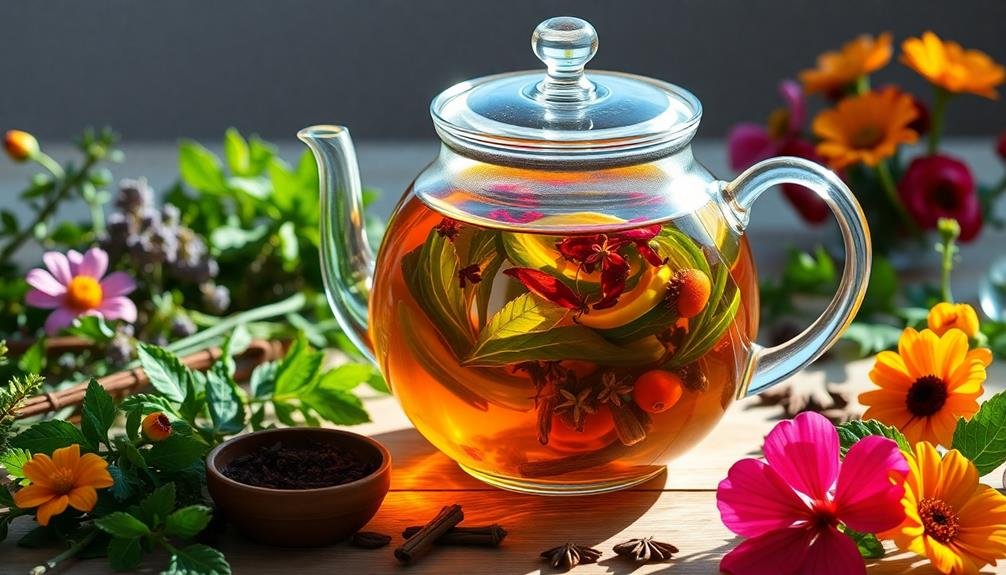
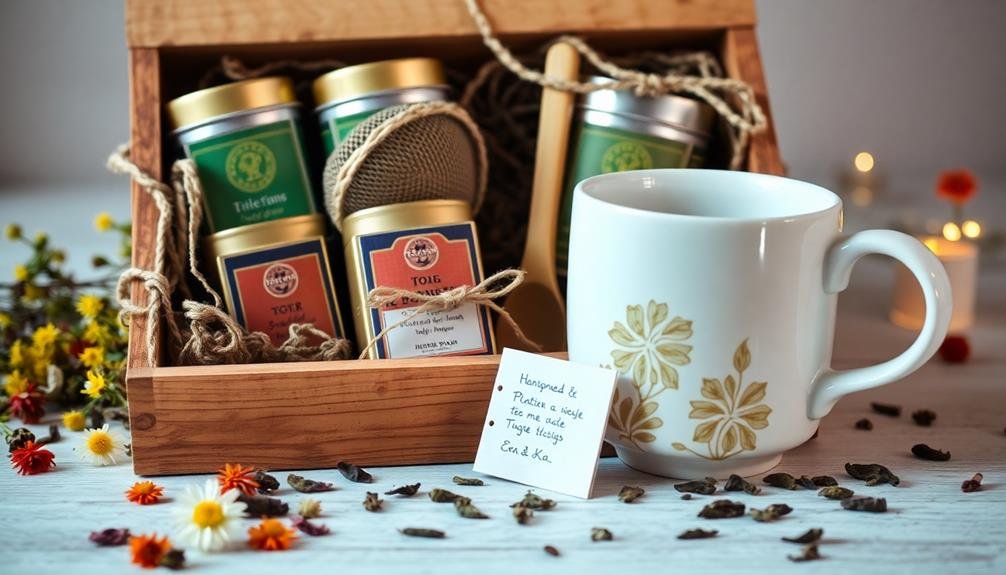
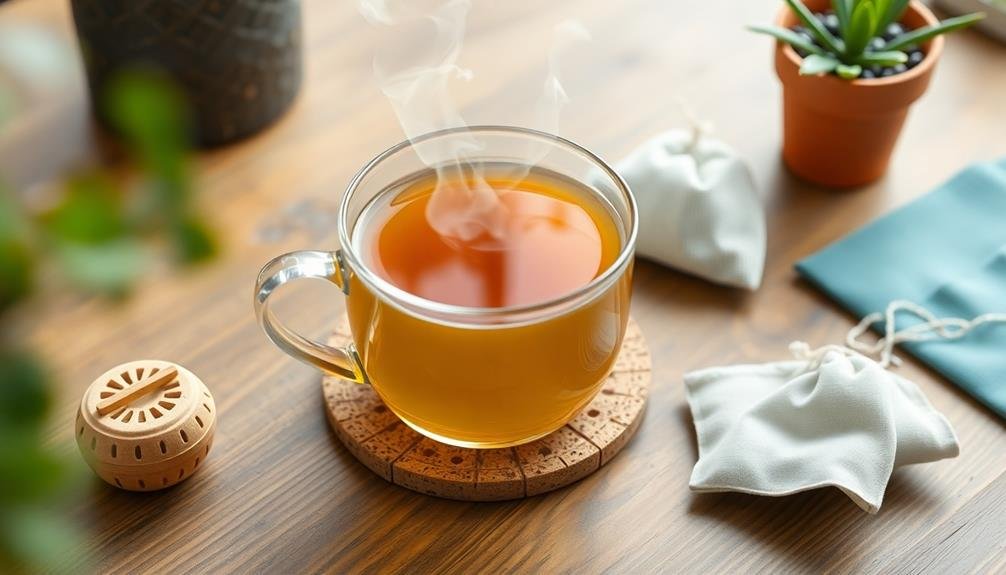

Leave a Reply